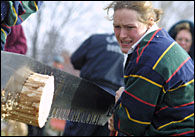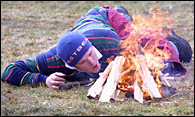Going against the grain
Lots of wood chips, flashes of steel, grunts and logs set the mood on Centennial Field at Macdonald Campus two Saturdays ago. The annual intercollegiate woodsmen competition was on.
Mac hosts one of the four contests each year, as do the University of New Brunswick, Sir Sanford Fleming College in Ontario, and Nova Scotia Agricultural College -- all part of the Canadian Intercollegiate Lumberjack Association. Teams of lumberjacks and lumberjills also come up from the States to compete for glory in these timbersports contests.
This year, the weather was a balmy 6º -- athletes often compete in -30º weather. There was the snowshoeing and swede saw combo. There was axe tossing and the buzz of chainsaws.
Different events go on at once. I first notice the log deck: brawny women rolling an ornery log down and along a ramp and up again using peaveys (levers with a pivoting hooked arm and metal spike at one end). The Tragically Hip and ACDC blare over loudspeakers.
 McGill timbersport athlete wields a bucksaw, racing against time.
McGill timbersport athlete wields a bucksaw, racing against time.PHOTOS: Owen Egan |
|
In another part of the field, young women pile on a fat log to keep it steady on the sawhorse, taking turns to saw off discs or "cookies" with a bucksaw (or crosscut), a long, toothy strip of steel. Further off, guys are swinging axes vigorously, slashing hapless wood.
McGill's woodswomen team captain, Valerie Samson, is having a hoot learning new skills at a sport she'd only learned about recently. "I like chopping and using my muscles. It's very physical." When she first came to Mac she had the option of trying out for rugby or being a woodswoman, "and I don't like to run too much."
Thanks to all the push-ups coach John Watson inflicts on the McGill team, Samson will be able to haul around feed bags with ease when she returns to the family dairy farm in Abitibi. "You don't see it but we're stronger."
She means to keep up the sport, maybe even go pro with her boyfriend. Samson proudly tells me the Macdonald women's team has won the last 12 competitions, due in part to their practices that begin at 6 am. They're currently in the lead for the overall title this year. The Mac woodsmen are points away from first place.
Watson has been running the Morgan Arboretum and coaching the Mac team for 26 years, just like his dad, Bob, before him.
 Woodsman coaxes flames in a race to see who can boil water the fastest using a log, three matches and an ax.
Woodsman coaxes flames in a race to see who can boil water the fastest using a log, three matches and an ax. |
|
In 1954, the McGill Outing Club invited Bob downtown to compete against their athletes in some old-fashioned crosscutting, chopping, sawing and other log-related activities. "They asked him to bring a bunch of farm boys," John says, "and they won a bunch of trophies and weren't ever invited back."
So back at Mac, Bob started up the first intercollegiate lumberjack competition ever. In 1971, McGill's first women's team competed against men, starting a trend for gals with axes.
"The students [on the team] are a good mix, direct from farm management, or dietetics," Watson says. "A lot come right off the farm." But as for bucksaws and peaveys, "Most have never even seen them." Farms all use chainsaws now. But the students are physically tough when they turn up for fall tryouts. "Most have been pitching hay all summer, so they're in pretty good shape."
A 40-foot pole was erected courtesy of Hydro-Québec for the pole-climbing event. Mac's Lydie Blanchard's strong shoulders suit her for the horizontal chop and pole climbing, which she loves and completed in 10 seconds this year. "It's tough, I like the challenge." She grew up on a dairy farm, but as for exposure to timbersports? "I didn't know what it was, so I tried it out and I liked it."
NSAC coach Rick Russell tells me climbing times used to count for scurrying up and down the 40-foot pole, but after a few broken legs from students sliding down too quickly, that changed. Now there are secure climbing ropes and students just go up as fast as they can. Russell put the pole climber's athleticism into perspective. "Imagine running up 40 feet of stairs in five-to-ten seconds. This is going straight up vertically."
This was Watson's favourite event. "Because I was a tree surgeon I was good at it." He held the record at 3.8 seconds. Later a student bested him with a boggling 2.9 seconds. "I told them the watch must have frozen," Watson jokes. Pro times are 12-13 seconds for 100 feet, up and down.
In Sophie Forget's first year, she heard friends talk about the fun they had on the McGill team. When she saw a show she was struck by the originality of the sport and tried out. Now she's inseparable from her teammates.
"We live together, we do sports together, we have a lot of common points." They all go out on Thursday nights, and party after the competitions. "We never drink before the events are finished," she says. They're smart enough not to get drunk and run around with axes, she laughs.
Forget is on the Jack and Jill team -- three men and three women working together. Her favourite event is the two-person crosscut saw with a male teammate. "The guys go faster and I like that, it pushes me."
Bill Deba is a judge at the event. He is also the producer and host of Lumberjacks Challenge, 13 episodes a year of timbersports brought to the small screen for your viewing pleasure. "It's a good 30 minutes of family entertainment."
Deba says he looks for consistency, takes care of complaints, mediates, and clarifies the interpretation of rules (which competitors are always stretching).
One young jack walks up to us with a broken wood "cookie" in his hand. He was D.Q.ed (disqualified) for his incomplete disc, and thinks he should have been told by the timer to take a second chance. Deba told him it's his responsibility to know the rules. He marches away crestfallen. "A rookie," Deba shrugs. "Probably first year. Did you see how thin he was trying to cut it?"
Deba tells me lumberjacks are those who use hand tools. Professionals are specialized now: loggers, foresters, cutters and the like. "No one uses hand tools anymore. It's all chainsaws," he explains. The skills nearly count as arcane knowledge, like discus or javelin throwing, but the lure for some remains strong.
For many it's a weekend passion. Coach Kevin Ransom of Paul Smith's College tells me about a breed known as "wood bums" in the pro world. Often single men, they have menial jobs, making just enough money to travel the competition circuit.
Competing began in the log camps in the 19th century. "It was a macho thing, to see who was the bull of the woods," Deba tells me.
One of the most exciting events to watch is also the most subtle: the water boil. It's Russel's favourite. "It takes an amazing amount of talent." Competitors boil a can of water armed only with an axe, a log, and three matches.
How to do it? Whack the log with the axe and make slats, shavings and "pencils." Brace the tin above the shavings, which you light by striking a match on the back of the axe.
Build up a wooden scaffold around the tin so it's soon engulfed by flames. Throw your body on the ground, curled around the inferno and blow on it like the dickens. Try not to become a human torch. (I saw sparks land on one guy's moustache.) The water's soapy; the time is called when the tin foams over.
The fastest collegiate time Russell has seen is 2:41. The pro record is 1:58 -- you can't boil water that fast at home. Traditionally this event takes place at the end of the day, and the fires get combined into a big bonfire and the partying begins.
Samson has the best time of the day at 3:58. "I didn't used to like it, but I had to practice hard and I got good at it. But it's hard on the hands; you hit them a couple of times. I get cuts, bruises -- a lot of cuts."
Other than sore muscles, cut fingers are usually as bad as it gets. Although one year during practice, Samson tells me, the head of an axe slipped off the handle and hit a guy in the head. Blunt end, fortunately. By the time he got to the hospital, it was too late for stitches so he just left the wound as is.
"We're all farmers, so we're all stubborn -- we think we don't need stitches." Years past have seen peaveys and axes meeting legs in all the wrong places.
Some pro-level competitors are watching. Kevin "Stumpy" Moynihan, a machinist from near Rochester, was here to catch up with his extended timbersport family and pick up a saw from a local sawyer. "Best saw men are from Quebec," he says. But the New Zealanders are the best choppers. Down under, timbersports are the number one sport after soccer.
Since Watson started, "the equipment is much more fine tuned, much more expensive." With this change comes dependence on the tools. "I used to like the person to win," Watson says. But now whoever has a $5,000 saw has a cutting edge. "It's taken a lot out of the sport. I think they should standardize the equipment." He'd also love to see competitions between East Coast and West. "I'd love to go out to BC with my 22 team members and beat the tar out of them."
Watson finds it "a lot of fun, working with the students. Everybody, no matter who, can develop the skills to become a good woodsman. It's great watching them develop, from knowing nothing in the first year, then at the end of their third year, they could go onto the pro competitions." There are worse fates. The world champion from Australia made $175,000 last year. "That's a lot of money for just swinging an axe."

